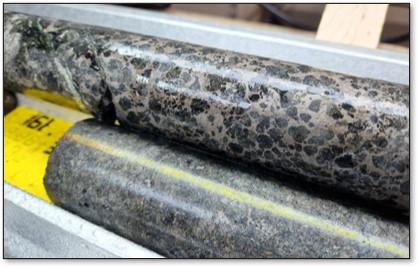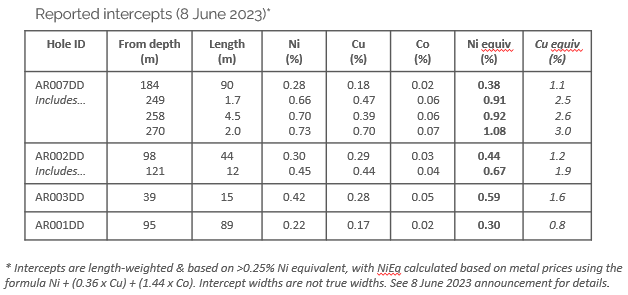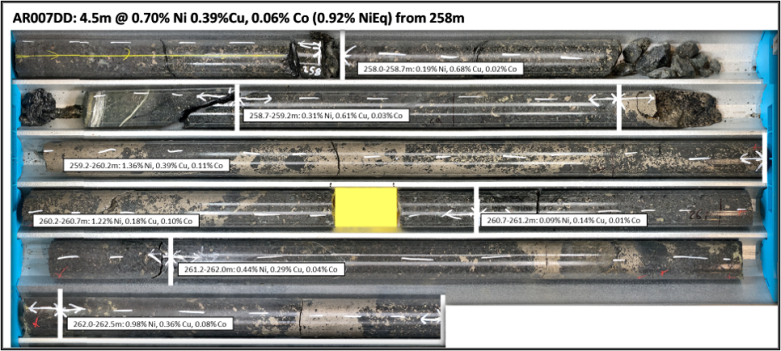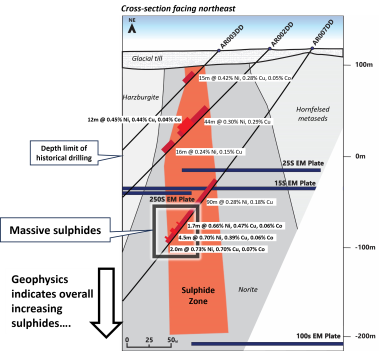Arthrath Project
Background
Nickel-copper sulphide mineralization was discovered at Arthrath by Rio Tinto (RTZ) in 1968 during a regional exploration programme. Geochemical and geophysical exploration followed by drilling discovered several sulphide occurrences within a dyke-like mafic-ultramafic intrusion. The most significant deposits were found at the Arthrath Central and Muirtack localities, which were drill tested in the early 1970s.
In 2005, Alba Mineral Resources reported wide intersections of mineralized sulphides in two drillholes at Muirtack which included 109.7 metres grading 0.26% nickel and 0.29% copper from 103 metres downhole depth.
Aberdeenshire Council's Local Development Plan 2023 (Appendix 14) identifies the Arthrath deposit as a “safeguarded site” whereby other forms of development are discouraged to prevent mineral resources being sterilised.
Geology
Nickel-copper sulphides at Arthrath are hosted within a 7 kilometre long, dyke-like intrusion which forms an east-west trending appendage to the Arnage-Haddo House Intrusion. This is one of several large gabbroic bodies included in the "Younger Gabbros" suite of mafic-ultramafic rocks believed to have formed 470 million years ago during the Grampian Event of the large mountain-building event known as the Caledonian Orogeny.
The sulphides primarily occur within a gabbronorite unit which ranges in composition from orthopyroxene rich cumulates to more feldspathic rocks, close to the outer margin of the intrusion where it is in contact with Dalradian metasedimentary rocks. These country rocks, where observed in drilling, include metaquartzites which have formed magnetite rich hornfels due to contact metamorphism from the intrusion. Xenoliths of hornfels are commonly observed within the gabbronorite indicating there has been significant assimilation of the country rock within the intrusion.
Within the gabbronorite there is evidence of a cryptic formation with magma mixing, hybridisation and wallrock assimilation, indicative of a dynamic magmatic environment suitable for the concentration and accumulation of conduit-related massive sulphides.
The size and geological setting of the Arthrath intrusion (comparable to global deposit analogues, see image below), evidence of a dynamic magmatic environment, and high volume of sulphide provide strong criteria for economic nickel-copper sulphide deposits at Arthrath and its surrounding district.

Overview of the Arthrath intrusion, showing distribution of historical shallow drilling and same-scale comparison to the footprints of major conduit-related nickel sulphide deposits.
Mineralization
Sulphide mineralization at Arthrath occurs as a classic, simple pyrrhotite-pentlandite-chalcopyrite assemblage, consistent with the magmatic sulphide deposit type worldwide. The sulphides occur as blebby disseminated sulphides increasing locally to net-textured and massive sulphides. The volume of sulphide is very high in the gabbronorites indicating a highly sulphide saturated magma.
At the Arthrath Central deposit, the focus of Aberdeen Minerals' drilling, nickel-copper-cobalt mineralized sulphides form a steeply dipping zone which is over 600 metres long, up to 70 metres wide and is drill confirmed to at least 300 metres vertical depth. The deposit remains open beyond this (no deeper drilling).

Net-textured sulphides in Arthrath drilling.
Drilling results
Aberdeen Minerals completed its maiden drilling campaign at Arthrath Central in February-April 2023 and announced its results in June 2023. Seven angled core drill holes ranging in length from 130 to 400 metres were completed for a total length of 1,715 metres.
Highlights from this programme include:
- Validation of historical data for use in modelling and resource estimates - two 1970s holes were twinned
- Drill confirmation of a wide, continuous, sulphide rich magmatic system
- The deepest hole ever drilled at the project, AR007DD, intersected massive sulphides 100 metres below the historical drilling
- includes 4.5 metres grading 0.7% nickel, 0.4% copper, 0.06% cobalt (0.92% nickel equivalent)
- This breakthrough intercept is open (untested) at depth and along strike
- Validation of geophysical model based on SkyTEM data, which indicates sulphide intensity increases with depth.



Arthrath cross-section.
Independent Technical Assessment Report
In October 2023, CSA Global (now part of ERM) delivered an Independent Technical Assessment Report (ITAR). This first ever JORC compliant technical report on the Arthrath Project, authored by global nickel expert Tony Donaghy, consolidated the technical credentials underpinning the business. The report concludes that Aberdeen Minerals has:
- “demonstrated the potential to delineate economic nickel-copper sulphide mineral deposits at Arthrath, and in northeast Scotland in general”, and
- “formed a sound exploration strategy to investigate that potential”.
The report makes several technical recommendations which are being followed up by the company.
Exploration model
The company's modelling of drilling and geophysics data has identified a large scale, textbook environment for formation of massive sulphides within velocity traps and other settings immediately below the current level of drilling. This conduit-related setting is comparable to global deposit analogues such as Nova-Bollinger (Australia), Tamarack (USA) and Sakatti (Finland).
The next phase of exploration at Arthrath will include deeper drilling with borehole electromagnetic (BHEM) surveys to explore for high grade massive sulphide bodies within the large scale sulphide rich system.


